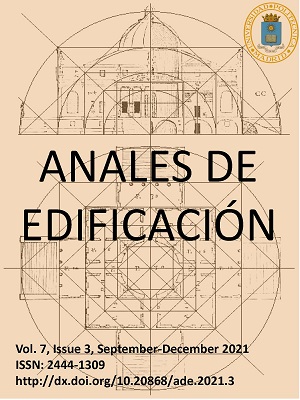Comportamiento térmico de placas ecológicas de yeso con escorias blancas de acería = Thermal behavior of ecological gypsum boards with white steel slag
DOI:
https://doi.org/10.20868/ade.2021.4974Palabras clave:
Placas de yeso, Escorias blancas, Cobmportamiento térmico, Reacción al fuego, Plasterboard, White slag, Thermal behavior, Reaction to fireResumen
El presente estudio analiza el comportamiento térmico de placas de yeso fabricadas con adición de escorias blancas de Horno Cuchara LF, con sustituciones progresivas de yeso por escoria del 20%, 40%, 60%, 80%. Se estudia la reacción al fuego, la termogravimetría y la conductividad térmica en placas de yeso de (300 × 400 ×15) mm³. La adición de escorias blancas produce en las placas una variación significativa en los valores de conductividad térmica y del coeficiente de transferencia de calor por convección pared-aire, provocado por el aumento de la densidad y una mayor compactación del material y, por lo tanto, un menor aislamiento térmico. Asimismo, la respuesta frente al fuego y al incremento del calor mejora sustancialmente a medida que se incorpora mayor cantidad de escoria blanca, lo que produce una reducción en los valores de pérdida de masa muy relevante. Esto supone una ventaja para el uso en tabiques o protección en áreas industriales o con ambientes térmicos agresivos.
Abstract
This study analyzes the thermal behavior of gypsum boards made with the addition of white slag from Horno Cuchara LF, with progressive substitutions of gypsum for slag of 20%, 40%, 60%, 80%. The reaction to fire, thermogravimetry and thermal conductivity in (300 × 400 × 15) mm³ plasterboard are studied. The addition of white slag produces in the plates a significant variation in the values of thermal conductivity and the coefficient of heat transfer by wall-air convection, caused by the increase in density and greater compaction of the material and, therefore, less thermal insulation. Likewise, the response to fire and to the increase in heat improves substantially as more white slag is incorporated, which produces a very relevant reduction in mass loss values. This is an advantage for use in partition walls or protection in industrial areas or with aggressive thermal environments.
Descargas
Referencias
Alonso, A. Rodríguez, J. Gadea, S. Gutiérrez-González, V. Calderón. (2019) Impact of Plasterboard with Ladle Furnace Slag on Fire Reaction and Thermal Behavior. Fire Technology 55, 1733–1751.AENOR, "Yesos de construcción y conglomerantes a base de yeso para la construcción. Parte 2: Métodos de ensayo. UNE-EN 13279-2:2014." Madrid: AENOR: 2014.
D. A. Kontogeorgos, I. D. Mandilaras, M. A. Founti. Fire behavior of regular and latent heat storage gypsum boards. Fire Mater. 2015; 39:507–517. DOI: 10.1002/fam.2246
Rodríguez, S. Gutierrez-Gonzalez, M.I Prieto, A. Cobo, V. Calderón. Analysis of long-term corrosion behavior in mortars containing recycled ladle furnace slag using computerized tomography and SEM. Materials Corrosion. Volume 66, Issue 3, pages 199–205, 2015. doi: 10.1002/maco.201407697
G. Thomas. (2002) Thermal properties of gypsum plasterboard at high temperatures. Fire Materials, 26, 37-45.
H. Uysal, R. Demirboğa, R. Şahin, R. Gül. (2004) The effects of different cement dosages, slumps, and pumice aggregate ratios on the thermal conductivity and density of concrete, Cement and Concrete Research, 34, 845-848.
Descargas
Publicado
Número
Sección
Licencia
1. Los autores conservan los derechos de autor y garantizan a la revista el derecho de una Licencia Creative Commons Atribución - Nocomercial 4.0 Internacional que permite a otros compartir el trabajo con un reconocimiento de la autoría y uso no comercial.
2. Los autores pueden establecer por separado acuerdos adicionales para la distribución no exclusiva de la versión de la obra publicada en la revista (por ejemplo, situarlo en un repositorio institucional o publicarlo en un libro).
Salvo indicación contraria, todos los contenidos de la edición electrónica se distribuyen bajo una licencia de uso y distribución “Creative Commons"












